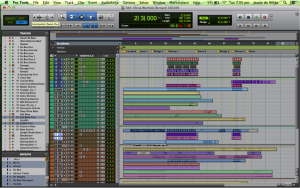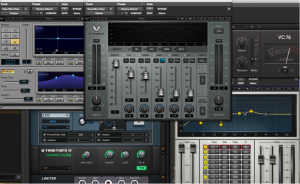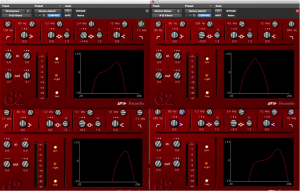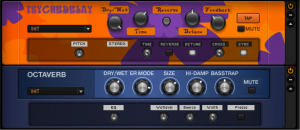Recorded in November/December 2015, but mixed in January, the song “Welcome” by AIM High School student Olivia Warhole Bernhard, was a good way to kick off 2016. A challenging song to record and mix because of the intricate amount of electronic programming involved. Producer, Adrian Legg from AIM High School did a whole lot of work in Logic, developing material from Olivia’s original demo, and then I’ve added a whole bunch of stuff too.
Two screenshots needed to cover this session – 55 tracks in total.

The light green tracks are my programming – mainly with Native Instruments Reaktor. There’s a great Ensemble inside that called “Go Box” which is heaps of fun as a sort of drum machine performance tool. These tracks are made up of random performances strung together, and then submixed down to a stereo pair.
The next set of green tracks are mostly Adrian’s percussion and noise tracks, gleaned pretty much from the standard Logic X set of sounds. Some of the sounds only happen once or twice and many are quite atmospheric. There’s also some drums in there through my own programming and Native Instruments Damage – which is a Kontact instrument. Oh man, they are insane!!!
Brown tracks are bass, which are all from synths – again mainly Adrian’s programming inside Logic. The main bass is the first track called “Deep Wave Bass” – I assume a Logic preset. But I went to town on this, and processed it with Waves Enigma, Waves Vitamin, Guitar Rig LFO stuff and filtering, VC 76 by Native Instruments and finally some Waves Q8 EQ. It ended up very different from the original, but much more “Deep Bass”.

I did some bass tracks as well, providing sonic juice through some tweaked Absynth and Massive presets.
Orange tracks are all synth parts – and all programmed by Adrian. He gave me lots of them, and through some careful arrangement, automation, plug-ins and processing I was able to fit them all in. The screenshot below is the EQ I used on the synth tracks. As you can see, it’s radical removal of frequency bands, in order to find space for the other synths. Although some EQ curves look similar, that’s fine, as the synths themselves don’t all play at the same time. As with most of the related instruments, the synths were sent down a submix channel.

The next tracks are the orchestral tracks that Adrian programmed in as well. These consisted of a few strings, French horn, cellos and basses. Not much in the way of processing here, but the whole submix was sent to a Big Hall reverb – essentially my favourite Native Instruments RC48 reverb.
The single green track is the lead vocal – comped from three different takes. I’ve been focusing on my vocal sounds recently and I’m never 100% satisfied, but I’m getting there. On this session, I used a hardware insert and sent the vocal to my Avalon 737 pre-amp. The vocal was originally recorded with one of these as well, so it’s gone through 2 stages of analog processing. I like to do this as much as possible, but I’m mixing so very little at home these days, so it’s hard to have the time to connect it.

From the Avalon, the vocal chain is a Focusrite D3 compressor. I’ve recently acquired all the older style Focusrite plug ins, so it’s been good to use it again. The vocal then went to the standard AVID BF-76 compressor. So the vocal has ultimately gone through 3 stages of compression in the mix alone! Probably too much, BUT Olivia’s vocal is nice and breathy, and the compression helps to bring that out. Again, it’s all moderately applied.
The vocal is being sent to a reverb (RC48), and also a delay. This is actually Guitar Rig – the “Psychedelay” to give me the repeats, and then “Octaverb” to soften the repeats.

All the blue tracks are numerous backing vocals – including the occasional “wolf howl” that you can hear in the final mix. There’s been also a few tracks where I’ve done the old reverse reverb trick to get the reverb happening first.
And finally the red tracks are all my effects returns and Master Buss. This one has got Maxim on it, but lately I’ve been using the Waves L1.
Lots of automation went on in this mix, and I went through my usual routine of getting rough balances first before automating section by section in detail. Adrian later on called for some more changes, which result in yet more automation to the orchestral tracks. I’m also really into automating sends – far more convenient than automating returns.
You can hear the final mix here! Check it out and let me know what you think.
You must be logged in to post a comment.